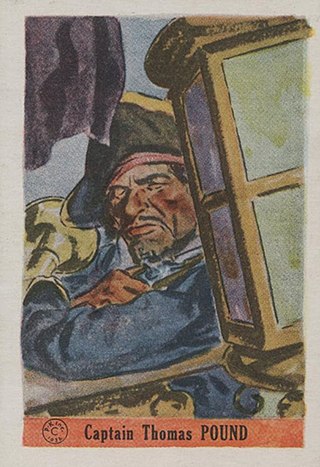Related Research Articles
Captain Samuel Bellamy, later known as "Black Sam" Bellamy, was an English sailor turned pirate during the early 18th century. He is best known as the wealthiest pirate in recorded history, and one of the faces of the Golden Age of Piracy. Though his known career as a pirate captain lasted little more than a year, he and his crew captured at least 53 ships.

Whydah Gally was a fully rigged ship that was originally built as a passenger, cargo, and slave ship. On the return leg of her maiden voyage of the triangle trade, Whydah Gally was captured by the pirate Captain Samuel "Black Sam" Bellamy, beginning a new role in the Golden Age of Piracy.

John Rackham, commonly known as Calico Jack, was an English pirate captain operating in the Bahamas and in Cuba during the early 18th century. His nickname was derived from the calico clothing that he wore, while Jack is a nickname for "John".
Robert Culliford was a pirate from Cornwall who is best remembered for repeatedly checking the designs of Captain William Kidd.
This timeline of the history of piracy in the 1680s is a chronological list of key events involving pirates between 1680 and 1689.

The Golden Age of Piracy is a common designation for the period between the 1650s and the 1730s, when maritime piracy was a significant factor in the histories of the North Atlantic and Indian Oceans.

Charles Vane was an English pirate who operated in the Bahamas during the end of the Golden Age of Piracy.
Jeremiah Cocklyn, better known by the name Thomas Cocklyn, was an English pirate known primarily for his association with Howell Davis, Olivier Levasseur, Richard Taylor, and William Moody.
Edward Coates was a colonial American privateer in English service during King William's War and later a pirate operating in the Red Sea and Indian Ocean.

Thomas Pound was an English Royal Navy officer who turned pirate and was briefly active in the coastal waters of New England during 1689. Caught and convicted of piracy, his crimes were forgiven and he later rejoined the Royal Navy.
Charles Harris (1698-1723) was an English pirate active in the 1720s. He is best known for his association with George Lowther and Edward Low.

The capture of John "Calico Jack" Rackham was a single-ship action fought between English pirate Calico Jack and British privateer Jonathan Barnet. The battle was fought in the vicinity of Negril, Jamaica and ended with the capture of Rackham and his crew.

Piracy was a phenomenon that was not limited to the Caribbean region. Golden Age pirates roamed off the coast of North America, Africa and the Caribbean.

John Auger was a pirate active in the Bahamas around 1718. He is primarily remembered for being captured by pirate turned pirate-hunter Benjamin Hornigold.
Captain Grinnaway was a pirate from Bermuda, best known for being briefly and indirectly involved with Edward Teach.

Robert Deal was a pirate active in the Caribbean. He is best known for his association with Charles Vane.
Phineas Bunce was a pirate active in the Caribbean. He was pardoned for piracy but reverted to it immediately afterwards and was killed by a Spanish pirate hunter.
William Coward was a minor pirate active off the coast of Massachusetts. He is known for a single incident involving the seizure of one small vessel, largely thanks to events surrounding his trial.

The Proclamation for Suppressing of Pirates was issued by George I of Great Britain on 5 September 1717. It promised a royal pardon for acts of piracy committed before the following 5 January to those pirates who surrendered themselves to the correct authority before a deadline. Originally, the surrender had to occur on or before 5 September 1718; this was later extended by a second proclamation to 1 July 1719.
References
- 1 2 3 4 Radune, Richard A. (2005). Pequot Plantation: The Story of an Early Colonial Settlement. Branford CT: Research in Time Publications. pp. 247–249. ISBN 9780976434108 . Retrieved 6 October 2017.
- 1 2 3 4 5 Jones, Sam (2016). The Pirates. Bradenton FL: New Word City. ISBN 9781612309521 . Retrieved 6 October 2017.
- ↑ Paine, Ralph Delahaye (1924). The Ships and Sailors of Old Salem, Massachusetts. Westminster MD: Heritage Books. pp. 39–40. ISBN 9780788437748 . Retrieved 6 October 2017.
- ↑ Sewall, Samuel (1878). Diary of Samuel Sewall: 1674-1729. V. 1 [-3]. Boston MA: Massachusetts Historical Society. p. 308 . Retrieved 6 October 2017.
- ↑ Mary was the daughter of Ann Glover, who had been hanged for witchcraft the previous year.
- 1 2 Edmonds, John Henry (1918). Captain Thomas Pound. Cambridge MA: J. Wilson and son. pp. 32–44. Retrieved 6 October 2017.
- ↑ Coward had originally served aboard the Rose; like Pound and Hawkins, he was convicted but soon received a pardon.
- ↑ Dow, George Francis; Edmonds, John Henry (2012). The Pirates of the New England Coast 1630-1730. New York: Courier Corporation. p. 70. ISBN 9780486138145 . Retrieved 6 October 2017.
